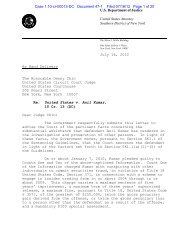Salz Review - Wall Street Journal
Salz Review - Wall Street Journal
Salz Review - Wall Street Journal
Create successful ePaper yourself
Turn your PDF publications into a flip-book with our unique Google optimized e-Paper software.
<strong>Salz</strong> <strong>Review</strong><br />
An Independent <strong>Review</strong> of Barclays’ Business Practices<br />
188<br />
waste of resource and is likely to lead to resistance to change. There are four key influences<br />
that have proportionately differential effects on encouraging change, of which peer<br />
pressure is the most influential (see Figure B.3). In a large networked organisation, the use<br />
of advocacy type interventions are possibly the most powerful drivers of change.<br />
Figure B.3 – Factors that Influence Change 281<br />
Peer pressure<br />
(30-50%)<br />
Personal ‘decision’<br />
to change<br />
(20-30%)<br />
Personal ‘feel’<br />
that change is possible<br />
(self-efficacy)<br />
(20-30%)<br />
Personal ‘buy in’<br />
outcome seen as desirable<br />
(10-20%)<br />
Finally, change brings with it a high degree of anxiety. This anxiety is typically associated<br />
with four factors: fear of loss of power or position, fear of incompetence (and loss of<br />
reward associated with previous competence), fear of loss of group membership; and fear<br />
of loss of identity. Schein describes these fears as learning anxieties. Creating psychological<br />
safety is vital to achieving change and Schein identifies that the majority of major change<br />
programmes fail because they do not pay sufficient attention to creating this psychological<br />
safety. Schein cites eight activities (see Figure B.4) required to ensure psychological safety,<br />
none of which can be missed. Delivering transformational change cannot be done without<br />
all eight factors in place. 282<br />
Figure B.4 – Eight Activities that are needed to Create Psychological Safety<br />
1. A compelling vision<br />
2. Formal training<br />
3. Involvement of the learner<br />
4. Informal training of relevant surrounding support groups and teams<br />
5. Practice, coaches and feedback<br />
6. Positive role models<br />
7. Support groups in which issues and problems can be aired and shared<br />
8. Systems and structures that are consistent with the new way of working<br />
281 Alison Gill, The value of peer pressure in delivering cultural change, working paper, 2009.<br />
282 Edgar Schein, Organisational Culture and Leadership, 2006.
















